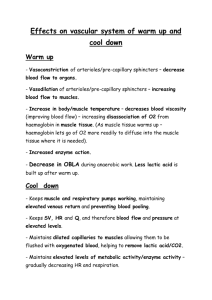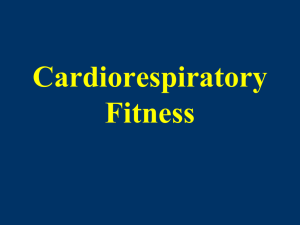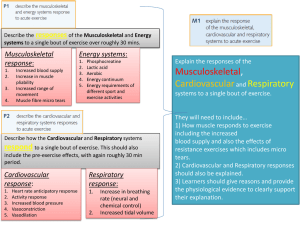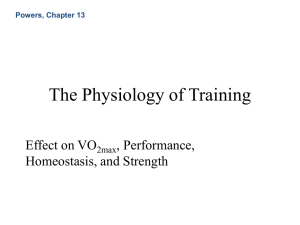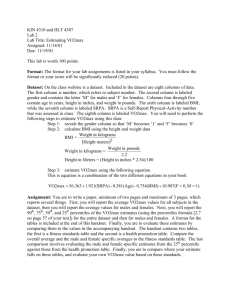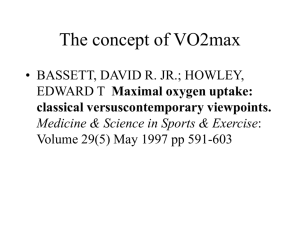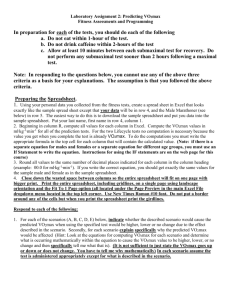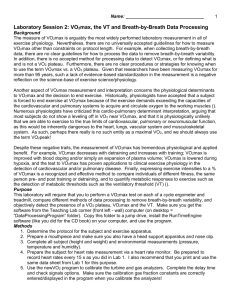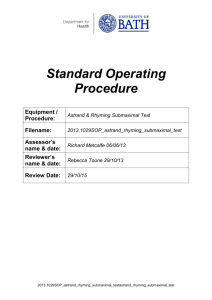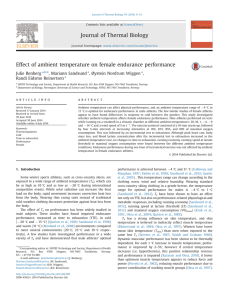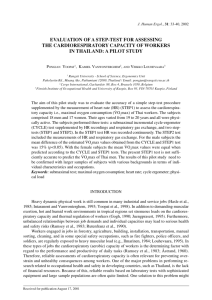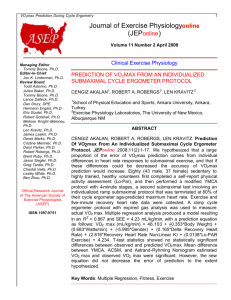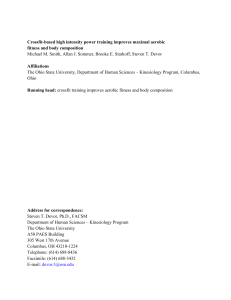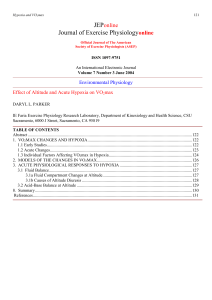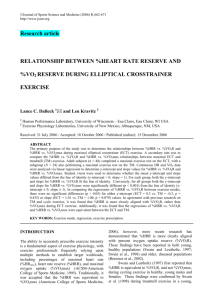Title : Adaptation to exercise
advertisement
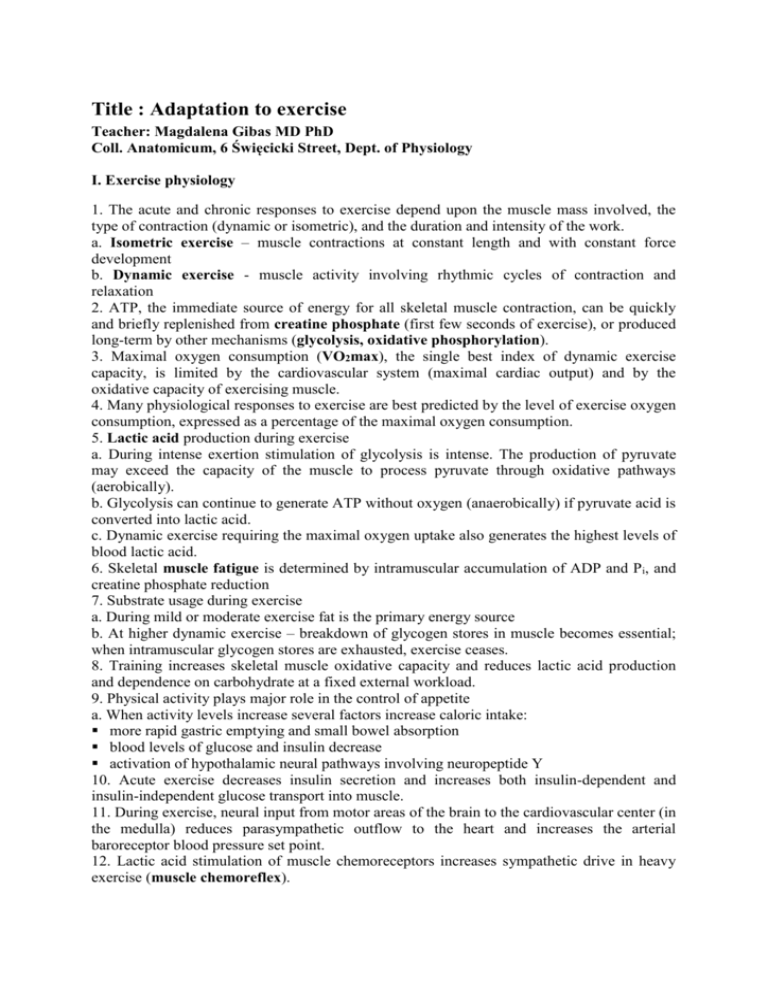
Title : Adaptation to exercise Teacher: Magdalena Gibas MD PhD Coll. Anatomicum, 6 Święcicki Street, Dept. of Physiology I. Exercise physiology 1. The acute and chronic responses to exercise depend upon the muscle mass involved, the type of contraction (dynamic or isometric), and the duration and intensity of the work. a. Isometric exercise – muscle contractions at constant length and with constant force development b. Dynamic exercise - muscle activity involving rhythmic cycles of contraction and relaxation 2. ATP, the immediate source of energy for all skeletal muscle contraction, can be quickly and briefly replenished from creatine phosphate (first few seconds of exercise), or produced long-term by other mechanisms (glycolysis, oxidative phosphorylation). 3. Maximal oxygen consumption (VO2max), the single best index of dynamic exercise capacity, is limited by the cardiovascular system (maximal cardiac output) and by the oxidative capacity of exercising muscle. 4. Many physiological responses to exercise are best predicted by the level of exercise oxygen consumption, expressed as a percentage of the maximal oxygen consumption. 5. Lactic acid production during exercise a. During intense exertion stimulation of glycolysis is intense. The production of pyruvate may exceed the capacity of the muscle to process pyruvate through oxidative pathways (aerobically). b. Glycolysis can continue to generate ATP without oxygen (anaerobically) if pyruvate acid is converted into lactic acid. c. Dynamic exercise requiring the maximal oxygen uptake also generates the highest levels of blood lactic acid. 6. Skeletal muscle fatigue is determined by intramuscular accumulation of ADP and Pi, and creatine phosphate reduction 7. Substrate usage during exercise a. During mild or moderate exercise fat is the primary energy source b. At higher dynamic exercise – breakdown of glycogen stores in muscle becomes essential; when intramuscular glycogen stores are exhausted, exercise ceases. 8. Training increases skeletal muscle oxidative capacity and reduces lactic acid production and dependence on carbohydrate at a fixed external workload. 9. Physical activity plays major role in the control of appetite a. When activity levels increase several factors increase caloric intake: more rapid gastric emptying and small bowel absorption blood levels of glucose and insulin decrease activation of hypothalamic neural pathways involving neuropeptide Y 10. Acute exercise decreases insulin secretion and increases both insulin-dependent and insulin-independent glucose transport into muscle. 11. During exercise, neural input from motor areas of the brain to the cardiovascular center (in the medulla) reduces parasympathetic outflow to the heart and increases the arterial baroreceptor blood pressure set point. 12. Lactic acid stimulation of muscle chemoreceptors increases sympathetic drive in heavy exercise (muscle chemoreflex). 13. Local factors dilate active skeletal muscle despite sympathetic vasoconstrictor drive, leading to vastly increased skeletal muscle blood flow in dynamic exercise. 14. Isometric exercise quickly leads to fatigue and sharply increases blood pressure because blood vessel compression blocks nutrient delivery, leading to lactic acid accumulation and chemoreceptor stimulation. 15. Dynamic exercise training increases VO2max, lowers blood pressure and heart rate. 16. Coronary blood flow during dynamic exercise a. During exercise it can exceed resting levels fivefold b. Chronically increasing the coronary blood flow alters the generation of endothelial nitric oxide and prostacyclin (vasodilators) 17. Input from motor areas of the brain stimulate the respiratory center to increase tidal volume and breathing frequency in exercise. a. In isometric exercise activation of hypothalamic motor areas (“central command” pathway) appears to be the only determinant of the ventilatory response. b. In dynamic exercise, feedback from peripheral receptors modulates the respiratory response. peripheral chemoreceptors (carotid bodies) sense deviations in arterial PO2 and pCO2 pulmonary stretch receptors limit tidal volume catecholamines possibly stimulate peripheral chemoreceptors 18. Ventilatory adaptations to dynamic exercise training a. The airways, alveoli, diffusional exchange barrier are unaffected by chronic dynamic exercise b. The endurance of the respiratory muscles increases with training. II. Measurement of Cardiovascular Endurance - classes A. The Astrand-Rhyming Step Test Many versions of the step test are available. Probably the most common is the original 5minute step test (Harvard step test). Another test called Astrand-Rhyming step test is often used, particularly with large groups of students. An accurate measurement of the heart rate is necessary if the results form this test are to be meaningful. If you have trouble counting your heart rate, the results will not be accurate. For this evaluation the pulse will be counted for 15-second counts while remaining seated. Refrain from talking and unnecessary movement during periods when heart rates are being counted; these activities can influence your results. Results should be recorded in the space below. TRIAL BEATS/15 SEC BEATS/MIN 1 _____ x 4_____ 2 _____ x 4_____ 3 _____ x 4_____ 4 _____ x 4_____ The step test is based on the premise that for all submaximal work the person with a higher level of cardiovascular fitness not only will have a smaller increase in heart rate but also will have a heart rate that returns to normal faster after the task than it would in a person with a normal level. Purpose The purpose of this test is to obtain immediate knowledge of the level of cardiovascular efficiency. Method Do not perform any activity before this test; no warmup is allowed. A 40-cm bench should be used for men, and a 33-cm bench for women. Step up to and down from this bench at the rate of 22.5 steps/min. The same foot must start the "stepup" each time, and an erect posture must be assumed. Continue the activity for a maximum of 6 minutes or until you are unable to maintain the set rate. The heart rate is counted for a 15-second period, starting exactly after completion of the last step. Results Record the results in the spaces provided. Time of stepping ______seconds Heart rate _____ beats/15 sec Use Astrand Ryhming nomogram to evaluate VO2max (see next page) Estimated VO2max can be determined by reading horizontally from the body weight scale (step test) or workload scale (cycle test) to the oxygen uptake (VO2) scale. The predicted VO2max value is obtained by connecting the point on the VO2 scale with the corresponding point on the pulse rate scale. Where the line intersects the VO2max scale is the estimate of the individual’s VO2max. Use Astrand Ryhming nomogram to evaluate VO2max. The nomogram will be provided during classes. To evaluate the cardiovascular endurance use the table: Maximal Oxygen Consumption VO2max (L/min) Age Women 20-29 30-39 40-49 50-65 Men 20-29 30-39 40-49 50-59 60-69 very low Cardiovascular endurance low average high very high 1.69 1.59 1.40 1.29 1.70-1.99 1.60-1.89 1.50-1.79 1.30-1.59 2.00-2.49 1.90-2.39 1.80-2.29 1.60-2.09 2.50-2.79 2.40-2.69 2.30-2.59 2.10-2.39 2.80 2.70 2.60 2.40 2.79 2.40 2.19 1.80 1.59 2.80-3.09 2.50-2.79 2.20-2.49 1.90-2.19 1.60-1.89 3.10-3.69 2.80-3.39 2.50-3.09 2.20-2.79 1.90-2.49 3.70-3.99 3.40-3.69 3.10-3.39 2.80-3.09 2.50-2.79 4.00 3.70 3.40 3.10 2.80 B. The Astrand-Rhyming submaximal cycle ergometer test It is designed to predict VO2 max from a 6 minute exercise period. It is one of the most widely used submaximal exercise tests. The testing procedure requires a steady heart rate at an appropriately selected submaximal work rate (kpm/ min or watts). This information together with a predicted maximal heart rate and an age correction factor, is used to predict the subjects VO2 max. Equipment required: Bicycle ergometer - metronome - heart rate monitor- timer - Astrand-Rhyming equations stethoscope (in case of failure of HR monitor) Pre-test Preparations: 1. Begin by adjusting the seats on the ergometer so that the subject legs are nearly straight when extended during pedaling. 2. A pedal frequency of 50 revolutions per minute is recommended for this procedure (some authors prefer 60 rev). You may recall that the bicycle ergometers have a readout that tells you pedal frequency as you are riding. Nonetheless, it is wise to make use of the metronome to be sure that pedaling cadence remains as close to 50 RPM's as possible. Only under these circumstances, can one expect accurate results. In addition, there may be circumstances where you need to look at other displays on the bike such as power output. 3. Begin by filling the appropriate information into the individual data form provided to you. Place the heart rate monitor on this subject and be sure that heart rate is being picked up by the wrist monitor. When the monitor is working properly and the subject is comfortable on the bicycle, resting heart rate should be taken and recorded on the form. Subsequently, the subject should demonstrate the ability to maintain pedal frequency at the prescribed rate. 4. Establish the power output at which the subject will ride based upon the information in the table. This is a single-stage submaximal cycle ergometer test. The test generally lasts 6 min. Initial work rate is established based on gender and fitness status. The following table provides initial work rate guidelines: Gender/Fitness Work Rate -1 Male/Unconditioned Male/Conditioned Female/Unconditioned Female/Conditioned (kg·m·min ) 300 or 600 600 or 900 300 or 450 450 or 600 Work Rate (watts) 50 or 100 100 or 150 50 or 75 75 or 100 -1 The objective is to establish a steady-state HR between 125 – 170 bts·min by the end of 6 min. Heart rate should be measured at the end of every min. Use Astrand Ryhming nomogram to evaluate VO2max. To evaluate the cardiovascular endurance use the table: Maximal Oxygen Consumption VO2max (L/min) C. Physical Work Capacity (PWC170) Test 1. The purpose of this test is to determine the work rate that can be performed at a heart rate of 170bpm (or 150bpm if the PWC150 is used). While this test is appropriate for people under 40 years of age, for those over 40 years it could be very close to (40 to 49 years) or exceed (50 years and over) the persons maximum heart rate. It is therefore recommended that a PWC150 test be used for people 40 years and over. 2. The PWC170/150 test is useful for prescribing exercise for people who intend to exercise on a cycle ergometer. It is also effective in measuring changes in cardio-respiratory fitness, indicating increased or decreased work rate at a heart rate of 170 or 150 bpm. 3. The structure of the PWC test is such that the subject exercises at two or more workrates, aiming to achieve a steady state heart rate of between 110 and 150 bpm (PWC150) and between 110 and 170 for the PWC170. Withers et al (1977) examined various combinations or workrates such as 2 X 6 minutes, 3 X 4 minutes and 4 X 3 minutes. They found no significant difference between the PWC170 values derived from the 3 protocols. However they recommended that workrates should be of at least 4 minutes duration in order to achieve a satisfactory steady state heart rate. Even with a short rest between workrates, successive 6 minute workrates tend to produce heavy leg fatigue. It is therefore recommended that a 3 X 4 minute protocol be used, with a 1 1/2 minute rest period between workrates. Astrand-Ryhming Data Sheet Testing site___________________________________ Date___________________ Individual data: Subject:____________________________ Gender:______________ Age:________ Ht.(cm)__________ Wt.(kg)__________ Circle: Conditioned/Unconditioned Workload:___________ Seat Height__________ Time for 15 beats (measured by 2 other students): 1._____________ 2.____________ Average heart rate_______________ In appropriate range? (circle) Yes No VO2 score from A-R nomogram_________ x Correction factor 1.05 = ____________ Cardiovascular endurance (from the table) _________________________________

